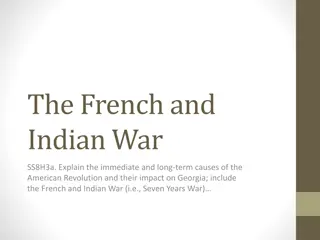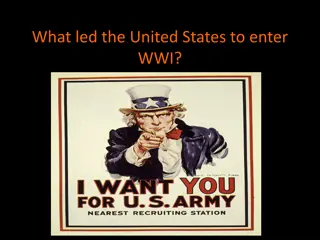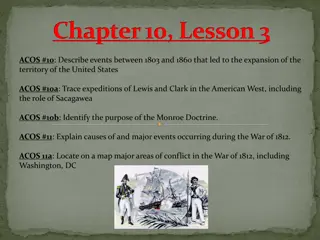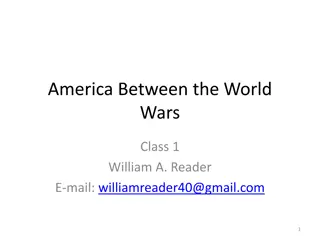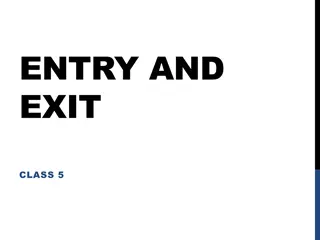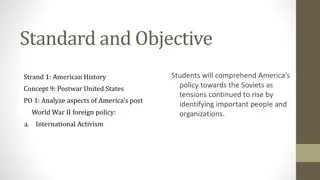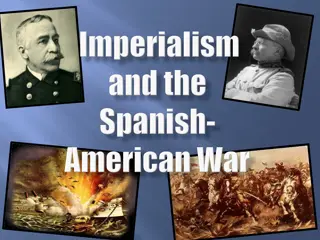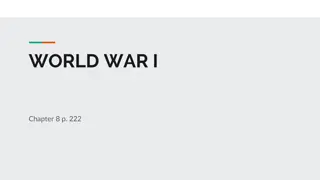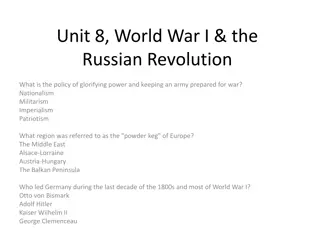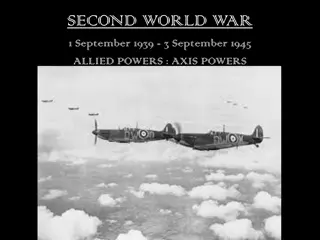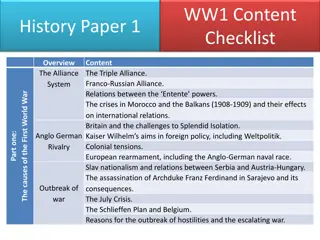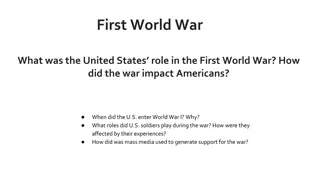America's Entry into World War I: Causes and Impacts
World War I and the 1920s witnessed America's transition from neutrality to active involvement in the war. Factors such as nationalism, militarism, imperialism, and alliances led to the conflict. The impact of technological innovations resulted in stalemate on the Western Front, leading to significant casualties. Explore the reasons behind America's entry into the war and the shift from isolationism to intervention.
Download Presentation

Please find below an Image/Link to download the presentation.
The content on the website is provided AS IS for your information and personal use only. It may not be sold, licensed, or shared on other websites without obtaining consent from the author. Download presentation by click this link. If you encounter any issues during the download, it is possible that the publisher has removed the file from their server.
E N D
Presentation Transcript
Topic 5 World War I and the 1920s (1914-1929) Lesson 1 America Enters World War I
World War I and the 1920s (1914-1929) Lesson 1 America Enters World War I Learning Objectives Identify the causes of World War I. Analyze the impact of technological innovations in weaponry that resulted in stalemate on the Western Front. Analyze reasons behind isolationism and neutrality in the United States before 1917. Explain why the United States entered the conflict on the side of the Allies.
World War I and the 1920s (1914-1929) Lesson 1 America Enters World War I Key Terms Alsace-Lorraine militarism Francis Ferdinand William II Western Front Casualties contraband U-boats Lusitania Zimmermann note
The Causes of World War I In 1914, nationalism, militarism, imperialism, and entangling alliances combined with other factors to lead the nations of Europe into a brutal war. The war quickly spread around the globe. The United States remained neutral at first but ended up abandoning its long tradition of staying out of European conflicts.
The Causes of World War I Nationalism Escalates Tension in Europe Militarism Increases Arms Production Alliances Between Nations Increase the Potential for War A Significant Assassination
The Great War Begins Everything was in place for a great conflict nationalist ambitions, large armies, stockpiles of weapons, alliances, and military plans. The nations of Europe were hurtling like giant trains toward a great collision. Archduke Francis Ferdinand s assassination was the incident that triggered this conflict.
The Great War Begins Alliances Cause a Chain Reaction Technological Innovations Lead to Stalemate The Reality of Trench Warfare
The United States Remains Neutral As the war spread in Europe, President Woodrow Wilson called for Americans to be impartial in thought as well as action. In a melting pot nation that tried to make Americans of peoples from diverse origins, Wilson did not want to see the war set Americans against one another. At first, most Americans viewed the conflict as a distant European quarrel for land and influence. Unless the nation s interests were directly threatened, Americans wanted no part of it. They preferred to maintain what they viewed as traditional American isolation from European disputes. Still, many Americans felt the war s effects and few were truly impartial in thought. Most held a preference for one or another combatant, and many businesses benefited from the increased demand by warring nations for American goods.
The United States Remains Neutral Many Americans Choose Sides U.S. Opinion Solidifies
Reasons for U.S. Entry into the War An internationalist, President Wilson sincerely desired peace in his country and around the world. Between the start of the war in 1914 and America s entry into it in 1917, Wilson attempted to use his influence to end the conflict among the warring countries. He failed in this great effort. Ultimately, he also failed to keep the United States out of the war.
Reasons for U.S. Entry into the War Britain Blockades German Ports Passenger Ships Fall Victim to the War at Sea Preparations for War The United States Is Neutral No Longer





